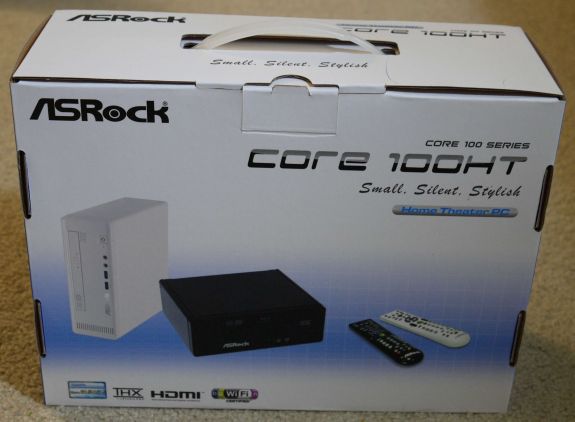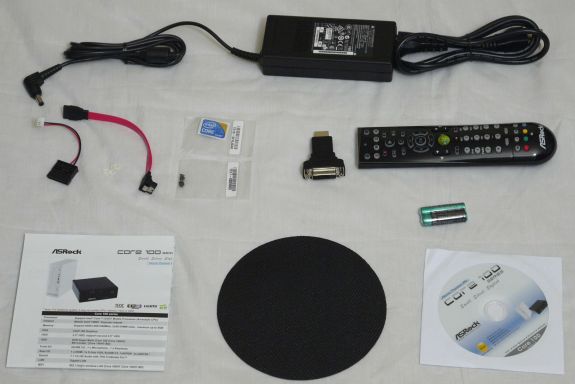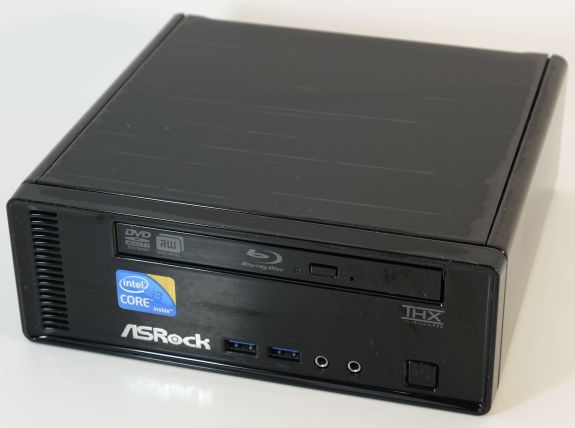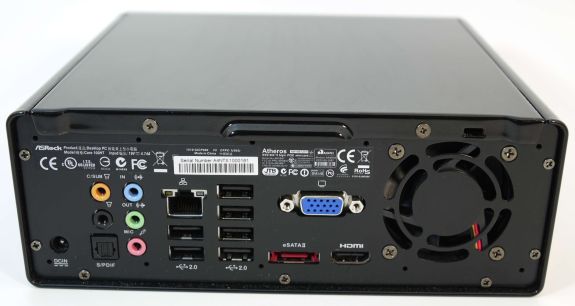ASRock Core 100HT-BD : Bringing HTPCs to the Mainstream Market [UPDATED : Noise Issue]
by Ganesh T S on July 19, 2010 9:34 PM EST- Posted in
- Home Theater
- Arrandale
- ASRock
- Media Streamer
- Core i3
- HTPC
The Core 100 HT-BD comes in a small package, and at first you wonder how such a powerful unit could come in such a small size.
Apart from the main unit, the package also bundles the following:
1. 90W AC / DC Adapter
2. SATA and power cables, as well as mounting screws for an optional second 2.5" hard disk
3. HDMI to DVI adapter
4. MCE remote and batteries.
5. Manual with instructions for disassembling and mounting the optional disk drive
6. Anti-slip pad for the base of the unit
7. CD with drivers and ASRock utilities
The appearance and dimensions of the unit are very similar to that of the ION 330-HT that was reviewed last August. The build quality of the chassis is top notch, and the unit will have no problem in blending with the A/V equipment of most consumers. However, the abrupt edges of the unit will not sit well with those interested more in the aesthetics and appearance rather than the internal capabilities of the unit. In the next iteration of the product, ASRock will probably work on the industrial design a bit more. Replacing the slimline Blu-Ray drive with a slot-loading type drive would also improve the appearance. These types of changes would enable them to cater to the segment of consumers who go more by the looks also.
We had mentioned in the ION 330 review about the absence of ports on the front panel being a bit strange, and ASRock has duly taken note, putting two USB 3.0 ports on the front panel. In addition, we also have headphone and microphone jacks in front. A set of vents on the left of the front panel helps in cooling the unit by maintaining air circulation. The slimline Blu-Ray drive is the same as those which make an appearance in various notebooks. The cost of such drives has come down drastically in the last 1 year, and we don't expect this component to add on too much cost over the DVD drive only version. Notably absent in the ION 330, but making an appearance in this unit is the THX logo above the power button to the right of the front panel.
ASRock uses the two sides of the unit as antennae for the Atheros WiFi module. Moving on to the rear of the unit, we find the adapter power input, followed by the audio ports. Analog audio output can be connected directly to the speakers, or the optical SPDIF output can be used to connect to older A/V receivers. Following this is the Gigabit Ethernet port, and 6 USB 2.0 slots. Further to the right, we have the VGA output (we really needed a DVI here), beneath which one gets the eSATA slot and HDMI output port. Wrapping up this panel is the ventilation fan. Our only gripe with the back panel is the placement of the eSATA port, which makes it difficult to connect external hard disks, particularly when the VGA port is being used.
Just like a notebook, this unit also supports simultaneous display on two monitors. Testing was done mostly with the HDMI output connected to a Toshiba REGZA 37" 1080p TV through an Onkyo TX-SR 606, and the VGA port connected to a old Dell monitor running at 1280x1024. It must be noted that the HDMI port on the unit is only 1.3a. This makes it impossible for the unit to drive monitors with resolutions higher than 1920x1080. Even extremely affordable 2048x1152 monitors such as this one from Dell are left unsupported at their maximum resolutions. However, we expect that this will not be a concern to buyers, since the unit will probably end up getting connected to a 1080p TV in most scenarios.
The Core 100 HT-BD ships with no OS installed. For the purpose of this review, we loaded up a copy of Windows 7 Ultimate x64. It is also possible to install Ubuntu or any other Linux distribution and still be able to take advantage of most of the HTPC functions of the system. Our analysis in the rest of the article, however, is completely from the Windows 7 standpoint.
Starting with this piece, all our media streamer and HTPC reviews will carry a table summarizing the data and A/V connectivity options for the unit from a home theater perspective. We will conclude this section with the same.
| Option | Status |
|---|---|
| HDMI | Yes [v1.3a] |
| Component | No |
| Composite | No |
| VGA | Yes |
| SPDIF | Yes [Optical] |
| Stereo | Yes |
| Option | Status |
|---|---|
| Optical Disk Drive | Yes [Blu-Ray] |
| USB | Yes [6 x v2.0, 2 x v3.0] |
| eSATA | Yes |
| LAN | Yes [ 1000 Mbps GbE ] |
| Internal HDD | Yes [ 500 GB ] |
| WiFi | Yes [ 300 Mbps 802.11n ] |
| Card Reader | No |














107 Comments
View All Comments
ganeshts - Tuesday, July 20, 2010 - link
Aikouka,Thanks for your insights.
1. Customers should hopefully be able to salvage some stuff from their previous setups (Blu-Ray playback software, keyboards and mice etc.)
2. We didn't do exhaustive testing on the VIA codec. Most of the time, it was disabled since we were using audio over HDMI.
3. The sticker is optional ( It comes as a separate label with the package, but you can choose whether to stick it in the front or not :) )
4. The build quality of the remote is not that great and there are better options out there as you observe.
5. Major drawback of ION is the lower general performance, higher power consumption and absence of HD audio bitstreaming. I think the $200 extra is worth it.
Aikouka - Tuesday, July 20, 2010 - link
1) It'd definitely be nice to harvest a few extra items from previous builds, but maybe a blurb about the overall cost of the software might be nice. I'm not sure, but it might help people sway toward or against the unit as being their Blu-Ray player, since you can easily just buy a decent separate unit for $100 or so. Another aspect that might sway some users is that the BR software will only truly integrate into WMC (last I checked). TMT3 has a plug-in for MediaPortal, but it isn't true integration (just loads the player and minimizes MP).I guess that all kind of goes with your talk on how it can be a pain to get all of the formats working, which let me tell you... I definitely agree with you on that! I had a point where using my laptop as a HTPC, I could get sound while playing MKVs through WMP, but not with WMC. It was the strangest thing :P.
3) Alright, that's good that the sticker is optional ;). I just wish manufacturers would push to not showing the rest of those connectors. It seems the consumer's desire is to have components that are PCs that don't look like PCs, but not many devices have those connections and if they do, they're typically hidden (except the PS3, but they're out of the way).
5) I think the main point I was trying to drive is that even though the ION is inherently weaker, does it still perform the tasks properly? I mean, you can take the kids to school in a Porsche 911 Turbo, but is it a tad bit overkill compared to a Prius? Do you really think the bitstreaming matters that much? I don't think most people would even be able to tell the difference between a good encode output from a SPU and the bitstream... I know I can't! :)
------------------
I like the articles though... I think the HTPCs are going to become more and more popular as people look for non-standard ways to get content. I've actually gone back to using my server as a quasi-HTPC to help alleviate the stress I was putting on my M1530. It's a little better now that I replaced some of its noisy components :).
vlado08 - Thursday, July 22, 2010 - link
" 5. Major drawback of ION is the lower general performance, higher power consumption and absence of HD audio bitstreaming. I think the $200 extra is worth it. "And what about picture quality? HQV v 2.0
The ION does the 23,976 but the Core 100HT - does not.
ganeshts - Thursday, July 22, 2010 - link
Good point, vlad08. The point mentioned was the drawbacks of the ION. Of course, if one wants to give the advantages of ION, they are as you mention.I think the average users just set the display refresh rate to 60 Hz and forget about it.. so the 24fps bug doesn't affect those.
Picture quality.. yes, maybe ION is better. We haven't done benchmarking on that platform yet (and will probably not do because it is a product from last year, and we have more exciting Nvidia stuff coming up) to confirm.
pirspilane - Tuesday, July 20, 2010 - link
Good point about the software costs. This is really a $900+ machine.The Mac Mini competes well with this machine when you consider:
- It comes loaded with some very nice software
- It's light years ahead, aesthetically
- It beats the AsRock on noise and power consumption
- Most people already have a Blu-ray player and don't want the aggravation of dealing with Blu-ray playback on an HTPC. I rarely use my HTPC (Corel WinDVD) to play Blu-rays because of the hassle factor.
tmservo - Tuesday, July 20, 2010 - link
While this seems like a good train of thought, it isn't. The poster above points out he uses pro (which is fine, I do too) but there is no reason why Home Premium, which has media center, wouldn't be used by the majority of users. So, $645 + $91. That's it, for anyone wanting the DVD model. Or, about $736.Your comparison at $900 is based on a comparison with a model featuring a Bluray Drive and Bluray software. This is not valid, because you're now comparing apples to oranges ;) The mac mini doesn't have, won't have, and doesn't support a bluray drive. So, the two aren't the same, at all. There just isn't a comparison.
Whether or not people have a seperate player already, there are lots of people who like the idea of 1 single box doing everything, like DVR, DVD, BD, Media Management, etc.
So, let's say you do a comparison on that front. So, the Mac Mini is $699. DVD only. Yes, it comes with software, but not really a front end for this.. so you download Front Row, which was last updated almost 2 years ago. You then go about hacking it to get your supports you need.
And you add a remote control, because the Mac Mini doesn't come with one. So, even if this remote is "flimsly and crap" you add a remote control that is say $50 (and don't say "iPhone" because then you're adding $300 in expense for a remote for everyone who doesn't have one).
So now the cost of your Mini with a remote is basically the same as this with a copy of Win7HP. Except, oh yeah, even if you get the DVD one of this, your ability to later convert to BD is there. Not at all on the other front. Remote wakeup? Yep. Since neither have tuner slots, both would be using say a network tuner. So, Silicon Dust HDHomeRun for both. So a wash on the cost here, except Front Row can't natively manage those tuners for anything, meanwhile Media center can.
You can buy software to do that on the mac.. now you've spent more money.
The Mac Mini is a good unit as a desktop. But for an HTPC, you spend a lot of money for almost no bang. You can get an ION based unit at about $350 that is DVD based that gives you the exact same features.... plus LPCM for your MKVs that the Mini doesn't do worth a damn.
Nothing against the Mac, but not every purpose works out for it. This just isn't one where you say "wow is that a great solution for a Mac". And AppleTV is a laughable product that should die a slow death.
Guspaz - Tuesday, July 20, 2010 - link
One reason that ASU *cough* I mean ASRock is always the first to put these out is probably that all of their SFF machines use the exact same case, nearly the same packaging, and mostly the same pack-in material.They've used this exact same case all the way back to their first Atom machines. Their ION machines also used this case, as did their bluray machines.
Now that they've introduced some CULV machines, surprise, same case again.
kwrzesien - Tuesday, July 20, 2010 - link
True.And why is it narrow and tall? Why can't they put this in a DVD-sized case with the industry standard width? The front should look just as clean as a nice DVD player, with the front ports, buttons and maybe even the drive behind a fold-down door.
whartsell - Tuesday, July 20, 2010 - link
"Unfortunately, there is no single unified interface (from XBMC or MediaPortal or any other similar program) which could successfully play back all the files from within. "Cant SageTV play back all the tested formats?
dukero - Tuesday, July 20, 2010 - link
I wish I seen this coming last month Just about finished building one ECS itx mobo and i core 3 530 in jetway 101 case and mines going to end up at about grand after software and tuners. And as far as tuners go for the asrock get a USB or homerun Ethernet.